
When I was new to climbing, Font 7A was a grade that I looked up to and thought 'one day.' It was a grade that heroes climbed and I'd only ever met a handful of people that had reached the mythical level. Once I had reached that level myself, I was chuffed and reflected that actually, it's a very achievable aim for people with some dedication and motivation.
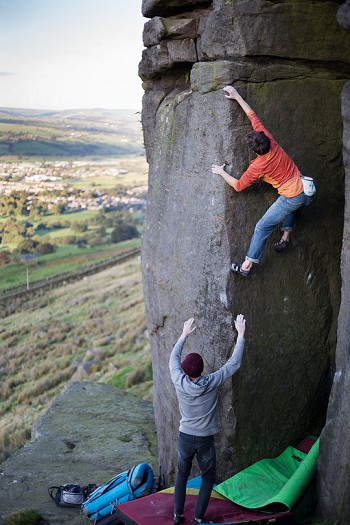
The most important factor when looking to climb Font 7A is climbing consistently. To reach a level which is technical and strength dependant will require regular climbing. If you're gunning for this grade, don't expect to climb it after a couple of months off. Regular visits to the wall or local crag will help you achieve your aims.
Choose the right footwear
You'll want a pair of shoes that work best for the shape of your feet. Work out whether you prefer a stiff or a soft shoe; both are good but one lacks sensitivity and one lacks support. Do you need a shoe with a toe profile that bends your knuckle? I.e. a downturned shoe. You may find that if your project is on the steeper side that a downturned shoe would help to pull your body closer into the rock. On the other hand, a downturned shoe is unlikely to be as useful on a slab, which may require a flatter, flexible shoe with good rubber.
Fingers Fingers Fingers
Malcolm Smith's catchphrase 'Fingers fingers fingers' is a useful reminder that Font 7A can be very technical and require a high strength base level. You're likely to come up against some holds that require a severe tug, so it's worth getting your body used to pulling hard. Once you've picked your problem, test yourselves on similar climbs down at the local wall – for instance if you have chosen a steep, thuggy problem, climb on problems that are representative of this style.
Learn about conditions
Trying to climb on rock in bad conditions can be similar to banging your head against a brick wall and is best avoided. Temperature is a huge factor – boulder problems that you try in the winter are often impossible when tried in the summer. Learn how things such as crag aspect, wind direction, humidity, sunlight and rain can affect overall conditions. This can halt swift loss of motivation, skin deterioration and ultimately lead to you having a better day at the crag.
It's not always about getting to the top
Remember to take positives from a session and not feel disheartened if you didn't complete your project, or climb the amount you wanted. Focus on whether you managed to get slightly higher, or somewhat less tired. Maybe you managed a single move that you couldn't do in the previous session. Take these as positives and use them as markers to show the improvement you're making. Marginal gains are what will eventually make you a great climber.
Work your technique
When looking at the best climbers, it's easy to think 'I need to fingerboard, campus, do weighted pull ups and diet to within an inch of my fat reserves.' However, most climbers don't realise that what they require most, is simply more climbing. Try problems that don't suit you, climb on rock frequently and find ways to climb that don't only involve your arms.
Instead of training to climb, train by climbing. Jump on climbs that you know are too hard and that you're not strong enough for. This will enable you to find other ways of getting to the top. Perhaps you'll try different foot placements, a heel or toe hook you've not tried before, or use drop knees to get more height. The ultimate aim is to avoid simply using strength, as you develop bad habits.
Skin Care
Snowboarders shatter bones, cyclists remove vast swathes of skin and climbers slightly wear down their skin, or develop very tiny cuts in their fingertips. Unfortunately, these 'injuries' can play a huge part in whether or not you can make gains on the day. You will reap the rewards of skin management if you can develop a good routine early on.
Sweaty skin makes everything feel several grades harder, so be careful not to let your tips become too thin and try to stop climbing before this happens. Diet can play an important role in keeping the sweat levels under control. If you binge on sugar before a session, eventually your energy levels will crash which makes you sweat more. Try to balance your climbing snacks with some slow release energy, like nuts for example.
Little flaps can become an epidemic if left to their own devices, so sand them down. If the worst happens and you look down to see a flapper, don't be a hero – use tape. This will mean you're able to climb for more days in a row and have more constructive sessions.
After climbing, be sure to wash your hands. If chalk is left on, it can dry the skin out and prevent all the useful moistures from regenerating the skin. For those lucky souls whose skin is too dry, investigate a moisturiser such as Climb On or Tip Juice to aid recovery.
Give yourself the best chance of succeeding
If you are looking to break into the next grade barrier, it's worth choosing a problem which plays to your strengths. If you're weak on overhanging problems, but have strong fingers – look at something vertical with small holds. If your technique isn't great, but you're strong – find a problem that requires some hard pulling. It's also worth thinking about rock type; if you find climbing on gritstone horrendous for instance, try going somewhere different like Wales or Northumberland. If you are struggling to work out how to climb a problem, ask someone how they climbed it, or failing that, watch a video - it's 2017. You may as well give yourself the best chance of succeeding.
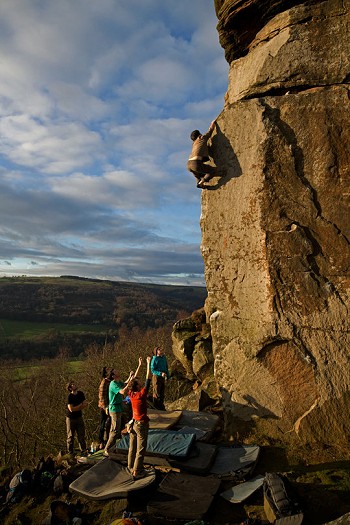
Find a project that inspires you
Get your teeth stuck into something that you actually want to climb, not something that may give you an easy pass into the next grade boundary. Look for a jaw-dropping line, a problem with a satisfying set of moves, or simply something you will find challenging. Succeeding on a boulder problem to which you've given blood, sweat and tears is a tremendous feeling and you can learn a lot from the process.
Listen to your mates
If you're unsure about how to progress from a technical and physical point of view, it's always worth getting someone to watch you climb and assess where you can improve. They may notice aspects of your climbing that you have never thought about, or identify different weaknesses. It can be difficult hearing constructive criticism, but try to keep an open mind.
Climb with someone who inspires you
Motivation is critical when trying to improve in bouldering. Try to climb with someone who inspires you – this may be a person who is leagues ahead and you gain motivation by trying get to their level. This person could also be a similar ability and spark your friendly competitive side.
Going to the local climbing wall is a great way to meet people to climb with. Organising regular sessions with someone who you find motivating can act as a catalyst and kick-start a huge improvement.
Go to Fontainebleau
All things become clear in the forest, although you will have to break through the initial frustration barrier. It's similar to the scene in Kill Bill where the protagonist is taught Kung Fu by continuously punching a piece of wood, until it shatters. Font is a strict teacher, sloppy footwork and poor body positioning will be dealt with harshly and without mercy. Don't be disheartened though, for everyone loves Font.
There are hundreds of colour coded circuits of all grades, where you can spend a day learning the intricacies of bouldering. For those who want to get stuck into something, there are thousands of world class problems on some of the most perfect sandstone on the planet.
Half-terms and Easter holidays are usually good bets for those with a family, as the weather is more tolerable.
Have a look at these ticklists for some inspiration:



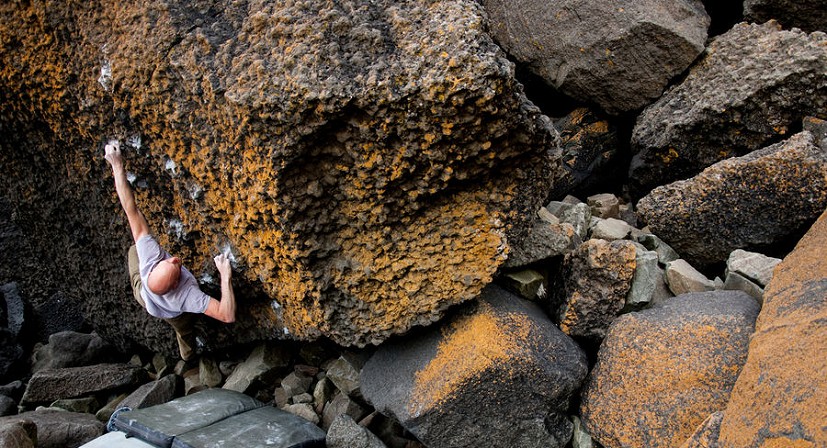
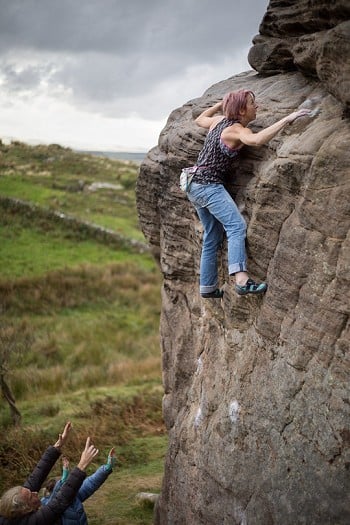
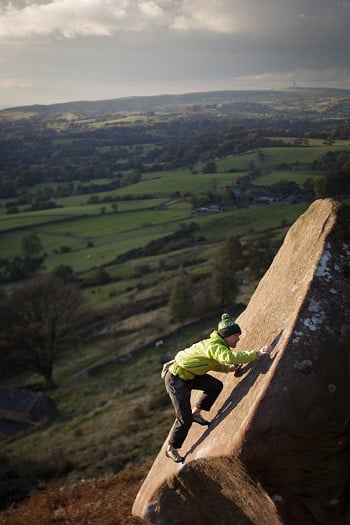
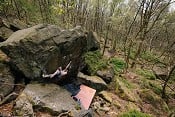
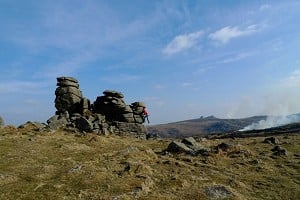
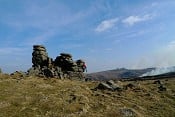
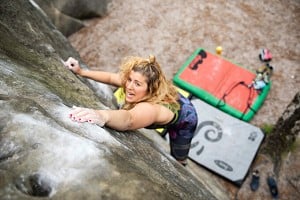









Comments